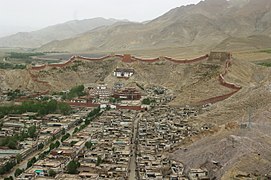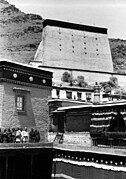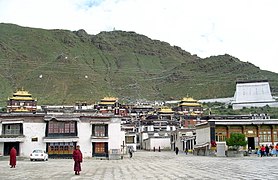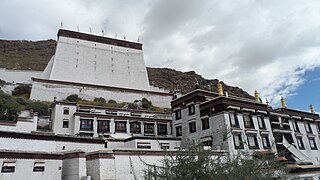Mur à thangka

Un mur à thangka (tibétain : göku tramsa ; chinois : 晒佛台 ; pinyin : ; litt. « support d'exposition du Bouddha »[1]) est, dans certains grands monastères tibétains, une haute et étroite construction en maçonnerie de pierre, de plan rectangulaire et en forme d'écran, bâtie à flanc de colline et en position dominante, pour servir à la suspension et à l'exposition, en plein air, de thangkas monumentaux en soie fabriqués selon la technique de l'appliqué[2], comme lors de la fête de l'exposition du grand thangka du Bouddha au monastère de Tashilhunpo à Shigatsé ou de la fête de l'anniversaire de Bouddha (Saga Dawa) au monastère de Palcho à Gyantsé. Des structures similaires se rencontrent dans l'aire d'extension du bouddhisme vajrayāna[3].
Appellations
[modifier | modifier le code]À Tashilhunpo, le mur a pour noms « kugopea » (Samuel Turner, 1800), « gö-ku-pea » (Laurence Austin Waddell, 1895), « gos-sku-spe'u » (Michael Aris, 1982), c'est-à-dire « cloth-image tower » / « tour à image en tissu », pea ou spe'u signifiant « tour »[4], ou encore « kiku-tamsa » (Laurence Austin Waddell, 1895, Sarat Chandras Das, 1902), c'est-à-dire « support d'image en tissu », kiku étant la prononciation de goku.
À Palcho, le nom est « goku tramsa » (selon The Tibet Album, 2006), ou « gos sku thang sa » (Michael Henss, 2011), tramsa / thang sa signifiant « support », et goku / kiku « image en tissu »[5],[6],[7].
Dans les écrits de langue anglaise concernant ce type de bâtiment, on parle généralement de « thangka wall » (« mur à thangka ») (Andreas Gruschke, 2001 ; The Tibet Album, 2006 ; Diane Lange, 2016 ; Michael Henss, 2011 ; Tibet, Lonely Planet, 2015) ou parfois de « support wall » (« mur de support ») (Tibet, Lonely Planet, 2015) ou encore de « display wall » (« mur d'exposition ») (Ronald M. Bernier, 1997), l'emploi de « wall » (« mur ») étant métonymique (la partie remplace le tout). Dans Tibet. Le Guide du Pèlerin de Victor Chan, traduit de l'anglais (1998), on trouve « mur à thangka » (p. 910), mais aussi « tour du gheku » (p. 457).
Le zoologue allemand Ernst Schäfer, séjournant au Tibet en 1938-1939, donne le nom de « große Tangamauer » (« grand mur à thangka ») au support de thangkas géants du monastère de Tashilhunpo ainsi qu'à celui du monastère de Palcho.
Fonctions et morphologie
[modifier | modifier le code]Un mur à thangka sert à la suspension et à l'exposition de thangkas géants, ou monumentaux, dans certains grands monastères du bouddhisme tibétain[8],[9],[10],[11],[12]. Il se présente sous la forme d'un bâtiment de plan rectangulaire, long, étroit et haut, plat au sommet, à la face avant présentant un fruit prononcé et à la face arrière verticale[11]. Implanté sur un versant de colline de façon à dominer l'ensemble monastique et à être vu de loin, le mur à thanka est précédé d'une terrasse destinée à la manœuvre et aux fidèles[12],[13].
Il est utilisé principalement lors de fêtes de l'exposition du Bouddha (晒佛节) dans la région autonome du Tibet. Ces fêtes se déroulent à des dates différentes selon les lieux : au début du deuxième mois, dans la seconde décade du quatrième mois ou du sixième mois du calendrier tibétain, également pendant la fête de Shoton. Lors de cette dernière, il y a généralement du spectacle vivant tibétain[14].
Monastères disposant d'un mur à thangka
[modifier | modifier le code]Des murs à thangka géant sont visibles dans quatre grands monastères : Séra (Lhassa), Palcho (Gyantsé), Tashilhunpo (Shigatsé) et Riwo Dechen (Qonggyai). Le monastère de Drépoung, quant à lui, n'a jamais eu de mur à thangka, se contentant d'un versant de colline spécialement aménagé à l'ouest du monastère[15].
Monastère de Séra
[modifier | modifier le code]Près de l'ermitage de Chöding, lieu de retraite de Tsongkhapa avant la construction du monastère de Séra, se dresse un mur, nouvellement construit, destiné à suspendre un thangka géant représentant le bouddha lors de la fête du Shoton qui a lieu au mois d'août[16],[17],[18].
-
Aperçu du mur à thangka du monastère de Séra, derrière le bâtiment, à droite, en 2011
Monastère de Palcho
[modifier | modifier le code]Le mur à thangka, dit « goku tramsa », du monastère de Palcho (ou Pelkor Chode), à Gyantsé, se dresse, massif et austère, en haut d'un versant, dans l'angle nord-est de l'enceinte monastique (Victor Chan donne au bâtiment-mur le nom de « tour du gheku »[19]). Lors de la fête de Gyantsé, qui se déroule pendant le 4e mois de l'année tibétaine[20], il sert, une année sur deux, à suspendre un thangka monumental (goku ou gheku), conservé dans un sac en cuir dans la chapelle de Dorje Ying et ayant pour sujet principal Sakyamuni. Il alterne, l'année suivante, avec le gos sku de Maitreya. Un troisième thangka, celui de Dipankara, n'est plus exposé en raison de son état[21].
-
Thangkas central et latéral déployés sur le mur à thangka en 1938.
-
L'édifice dans l'angle supérieur de droite de l'enceinte en 2006.
-
Idem en 2010.
-
En 2014
Dans ses mémoires, l'explorateur américain, F. Bailey Vanderhoef, Jr., qui séjourna à Gyantsé en 1938 pour y photographier les danses exécutées par les moines lors des festivités annuelles, rapporte que le « pylône » (pylon en anglais), ainsi qu'il qualifie la structure, servait à l'origine également de « grenier à grain » (granary)[22].
Monastère de Tashilhunpo
[modifier | modifier le code]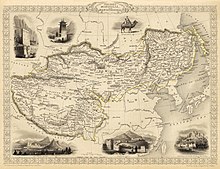
Le mur à thangka du monastère de Tashilhunpo (Shigatsé) est, selon Samuel Turner qui en publie la description en 1800, un bâtiment haut et large mais étroit situé à l'extrême nord-est du complexe monastique et répondant au nom de « kugopea ». Il contient, à ce qu'on lui a rapporté, les portraits des grands lamas ainsi que d'autres sujets sacrés relevant de la mythologie bouddhiste; il est affecté à la pratique de certains rites lors de festivités religieuses[23].
Un siècle plus tard, Laurence Austine Waddell décrit le même édifice, dénommé « gö-ku-pea » (qu'il traduit par The Stored Silken Pictures) car il servait à suspendre, lors de certaines fêtes, des tapisseries de soie gigantesques représentant Maitreya et autres divinités bouddhistes. Les fidèles appelaient le bâtiment « kiku-tamsa ». Il servait aussi d'entrepôt pour les carcasses séchées de moutons, chèvres et yaks réservées à la nourriture des moines. L'esplanade devant la structure accueillait la foule lors de l'exposition des thangkas monumentaux en juin et en novembre[11],[12],[24]. Le thangka déployé atteint les 40 mètres de longueur[25].
À la même époque, Sarat Chandra Das, qui s'est rendu au pied de l'édifice, lui donne alors plus de 200 ans d'âge et 60 pas de longueur et 30 pas de largeur, dénombre neuf étages, mentionne « kiku tamsa » comme désignation, signale son usage comme chambre froide et note que Turner en a fait un croquis en 1785 et a cru qu'il s'agissait d'un bâtiment religieux[26].
Un détail de la carte panoramique du Tibet méridional faisant partie de ce qu'il est convenu d'appeler la collection Wise, restitue le monastère de Tashilhunpo tel qu'il était au milieu du XIXe siècle avec son grand mur à thangka, les mausolées des quatre panchen lamas et le jardin Kiki Naga[27].
En 1986, l'alpiniste français Yvon Denard, visitant le monastère, suit, sur les pentes du mont Dromari, le chemin, ou kora, faisant le tour du complexe, et voit de près « l'immense mur blanc qui sert, en principe, une fois par an, à exposer le "thanka" géant, étoffe peinte à l'effigie du Bouddha. »[28].
-
Große Tangamauer (« grand mur à thangka ») (Ernst Schäfer, 1938).
-
Vue latérale arrière du mur avec ses deux contreforts (Ernst Krause, 1938).
-
Vue du monastère avec son mur sur la droite, prise depuis l'esplanade antérieure en 2005.
-
Vue latérale avant du mur avec son contrefort et sa terrasse en 2005.
-
Gros plan en .
-
Arrière du mur depuis le chemin du parikrama.
Monastère de Riwo Dechen
[modifier | modifier le code]Le monastère de Riwo Dechen, d'obédience kagyupa, sis à Qonggyai dans le Xian de Qonggyai[29], préfecture de Shannan, possède un grand mur à thangka géant[30],[31],[32]. Il se situe dans la vallée des rois, où l'on trouve les tombes de personnalités de l'Empire tibétain. Le monastère conserve un grand thangka de Maitreya, le Bouddha à venir[29].
-
Le monastère à flanc de colline avec son mur à thangka se dressant en amont (2008).
-
Le mur à thangka vu depuis un village éloigné.
Annexes
[modifier | modifier le code]Notes et références
[modifier | modifier le code]- (en) Yan-Bin Jia, « Zhaxi Lhunbo Monastery [扎什伦布寺] », sur Iowa State University, .
- Appelés thongdrels au Bhoutan.
- (en) Ronald M. Bernier, Himalayan Architecture, Farleigh Dickinson University Press, 1997, 196 p., p. 72 : « [...] a building of one of the region's most extraordinary structural types [is] in the background. Turner called it kugopea and Aris provides the Tibetan term Gos-sku-spe'u or "cloth-image tower." Its remarkable purpose is to provide a place for hanging a gigantic cloth artwork, sometimes called tapestry; as noted above, actually painting or applique of a type that may still be seen today, even at the Potala in Tibet. There is an example of such a display wall at Tibet's Shigatse monastery complex. The battered tower rises seven stories high and tapers towards its wedge-like top. It is white below with additional color (red ?) only at the very top story. To Americans, it is like the screen of a drive-in movie ; to believers it is a blank surface that they know will come to life at festival time. There is no stronger statement of the colossal in the mountains. Other such structures are found in Thimphu in Butan and elsewhere in the sphere of Vajrayāna Buddhism. It is architecture as drama, substance as dream. »
- (en) Michael Aris, Views of Medieval Bhutan. The Diary and Drawings of Samuel Davis, Segindia Publications/Smithsonian Institution Press, London - Washington, DC, 1982 : « The building in the foreground is the residence of the unidentified "Tessaling Lama" and the tall construction to the rear is what Turner called the "Kugopea" (Tibetan: Gos-sku-spe'u, "Cloth-Image Tower"). Its purpose was to serve as a frame for displaying once a year a gigantic tapestry of Buddhist divinities worked in applique of a type still seen during certain festivals in Bhutan today. »
- (en) Tibetcolor : « The earliest known use of applique to create huge thangkas dates from the fourteenth century when a giant image was designed by the 4th Karmapa Rolpe Dorje, 1340-1383. These huge appliques known in Tibet as "Goku", (silk brocade image), or "thongdrol", meaning liberation by sight. »
- (en) Terris Nguyen Temple (en) and Leslie Nguyen, The Giant Thangkas of Tsurphu Monastery, sur Asianart.com, 5 décembre 1995 : « Each great monastery in Tibet once possessed giant silk applique hangings for public display and worship. [...] The creation of such huge images is traditional throughout Tibet. [...] They are referred to as "gos.sKu." (pronounced Ki-gu) in Tibetan, literally means "Satin-image". These hangings are, in fact, constructed using a range of heavy brocades, silks and satins sewn together in the applique technique. »
- (en) Michael Henss, Liberation from the pain of evil destinies: the giant appliqué thang kas (gos sku) at Gyantse (rgyal rtse dpal 'khor chos de), in Proceedings of the Tenth Seminar of the IATS, 2003. Volume 13: Art in Tibet: Issues in Traditional Tibetan Art from the Seventh to the Twentieth Century, International Association for Tibetan Studies. Seminar, Charles Ramble, BRILL, 23 sept. 2011, 240 pages, pp. 73-90, p. 87 : « This huge 'tower for displaying the cloth image' (go sku spe'u) inside the great enclosure wall built around the Dpal 'khor chos sde in 1425 probbably was not erected before the 1430s, when the giant Gyantse banners were commissioned. This form of architectural 'image support' was constructed specifically for the display ritual. An earlier example of such thang ka walls still exists, albeit in ruined condition, at the nearby Rtse chen monastery (built 1366-1370). Besides the former gos sku dpe at Bsam yas (which, in its pre-1959 condition, was a 17th century reconstruction), the largest intact tower that has survived is at Bkra shis lhun po. »
- Victor Chan, Tibet. Le guide du pèlerin, Éditions Olizane, 1998, p. 457 : « Ce type de thangka (gheku) est destiné à être exposé en plein air et suspendu à de hauts murs rectangulaires bâtis à cette seule fin. »
- (en) « Thangka Wall, Tashilhunpo Monastery », sur chinapictures.org : « [The] Buddha Unfolding Festival is celebrated in Tashilhunpo Monastery from 14th to 16th of the 5th Tibetan month and unbelievable giant Buddha Thangkas will be displayed on this wall. »
- (en) « Annual Buddha-Painting Unfolding Festival in Tibet ended », sur tibet.news.cn, .
- Michael Taylor, Le Tibet - De Marco Polo à Alexandra David-Néel, Payot, Office du Livre, Fribourg (Suisse), 1985, (ISBN 2-82640-026-6), p. 86, fig. 54 : « Le « Kiku-tamsa » à Tashilunpo. Haut de neuf étages, le grand bâtiment étroit est un entrepôt ; les jours de fête, d'énormes tankas représentant Maitreya, le Bouddha du futur, étaient exposés sur ses murs blancs (Turner, op. cit.) ».
- (en) Laurence Austine Waddell, The Buddhism of Tibet, Or Lamaism, W.H. Allen & Co, Limited, London, 1895, p. 272 : « Hard by the last-named premises, is to be observed a lofty building of rubble-stone, reared to the amazing height of nine storeys. This edifice, which forms a very remarkable object on the hill-side, was sketched by Turner, who visited Tashi-lhumpo one hundred years ago, and his drawing of it is here annexed on opposite page. It is called Gö-Ku-pea, or "The Stored Silken Pictures," as it is used to exhibit at certain festivals the gigantic pictures of Maitreya and other Buddhist deities, which are brought out and hung high up as great sheets outside the walls of the tall building. By the vulgar it is called Kiku Tamsa. It is used as a storehouse for the dried carcasses of sheep, goats, and yak, which are kept in stock for feeding the inmates of the monastery. A wide-walled yard fronts the Kiku Tamsa, and this space is thronged by a motley crowd when (as is the custom in June and November) the pictures are exhibited. ».
- (en) William Carey, Adventures in Tibet: Including the Diary of Miss Annie R. Taylor's Remarkable Journey From Tau-Cahu to Ta-Chien-Lu Through the Heart of the "Forbidden Land", United society of Christian endeavor, 1901, 285 pages, p. 101 : « The most interesting building at Tashi Lhunpo is that called the Kiku Tamsa. [...] A large enclosure fronts the building; and twice a year, in June and November, immense crowds gather to gaze on the silken pictures of Buddhist deities which are hung over it for exhibition. »
- (zh) « 【解读】晒佛台 », sur 360.com, . Voir la série de photos montrant le hissage de la grande tapisserie de Tashilhunpo et de son voile multicolore à l'aide de cordes tirées depuis le haut du mur, puis son dévoilement au public.
- (en) Heinrich Harrer, Return to Tibet: Tibet After the Chinese Occupation, J.P. Tarcher / Putnam, 1998, 207 p., p. 183 : « Drepung did not have a special thangka wall like, for instance, Tashilhunpo or the lower white frontage of the Potala. At Drepung the thangkas were laid out on the ground: to the west of the monastery there was a marvelous slope that was ideal as a place to display the heavy applique roll of pictures. »
- (en) Tibet, Lonely Planet, 2015, 587 p. (version numérique non paginée) : « Sera Kora [...] Next to the rock paintings is a support wall used to hang a giant thangka during festivals. Chöding Hermitage. A path branches off the kora up side steps beside the thangka wall to the Chöding hermitage. »
- (en) Michael Henss, Liberation from the pain of evil destinies: the giant appliqué thang kas (gos sku) at Gyantse (rgyal rtse dpal 'khor chos de), in Issues in Traditional Tibetan Art from the Seventh to the Twentieth Century, Proceedings of the Tenth Seminar of the IATS, 2003, Volume 13: Art in Tibet (Erberto F. Lo Bue dir.), International Association for Tibetan Studies. Seminar, Charles Ramble, BRILL, 2011, 240 pages, pp. 73-90, p. 87 : « Most recently a huge image tower of this kind was erected at Se ra monastery. »
- (en) Banque d'images Alamy.
- Victor Chan, op. cit., p. 457.
- (en) "Service by thangka wall at Palkhor Chode, Gyantse", The Tibet Album, 5 Dec. 2006, The British Museum] : « People standing and sitting next to the Goku Tramsa wall of Palkhor Chode monastery, Gyantse, where the large embroidered thangka on display can just be seen in the left side of the image. This textile would be displayed during the Gyantse festival which took place in the fourth month of the Tibetan year. The wall [...] was high on the hillside around Gyantse in the north east corner of the monastery ».
- (en) Michael Henss, op. cit., p. 86 : « Because the damaged Dīpankara gos ku is not displayed, the display of the Maitreya alternates annually within a two-year cycle with the Sakyamuni gos ku. »
- (en) F. Bailey Vanderhoef, Jr., A Glimpse of Another World: A Journey Through Western Tibet (1938), edited with a foreword by José Ignacio Cabezón, a Joint Project of the University of California at Santa Barbara and the Santa Barbara Museum of Art, 2008, 135 p. : p. 77, « On the hill behind the monastery, there is an enormous stone pylon which has a flat sloping side facing the town and the plain. Though the building itself serves the double purpose of a granary, it was built for the ceremony of Tangka day on the fifteenth day of the fourth month, called Saga Dawa, when the monks hang on the pylon an enormous Tangka, or banner, bearing a picture of the Buddha. »
- (en) Samuel Turner, An Account of an Embassy to the Court of the Teshoo Lama in Tibet: Containing a Narrative of a Journey through Bootan, and Part of Tibet, G. and W. Nicol, London, 1800, 473 p., p. 313 : « towards the extreme limits of the monastery upon the north east, there stood a lofty and broad, but shallow edifice, styled "Kugopea", filled, as I was informed, with portraits of the sovereign lamas, and with other subjects appertaining to their mythology ; and solemnly dedicated to the festive celebration of some mystic rites of their religion ».
- (en) Tashi Lhunpo Buddha unfolding festival, sur le site Songtsan Travel : « Tashi Lhunpo Buddha unfolding festival has history of over 500 years. The festivals last for three days from 14th to 16th of the fifth month of Tibetan calendar. During the festival the huge thanka of Amitayus (the Buddha of longevity), Sakyamuni (the present Buddha) and Maitreya (the future Buddha) will be displayed on the monastery’s thanka wall successively ».
- Victor Chan, op. cit., p. 910.
- (en) Sarat Chandra Das, Journey to Lhasa in Central Tibet, J. Murray, 1902, 285 p., pp. 117 et 274.
- (en) Diana Lange, There’s More Than Meets the Eye with These Maps of Tibet, site de The Rubin, November 28, 2016 : « Tashilhunpo Monastery with the big thangka wall, the four Panchen Lama mausoleums, and the Kiki Naga Garden; detail of the panoramic map of Southern Tibet © The British Library Board, Add. Or. 3016, Folio 2 (detail). »
- Yvon Denard, "Thibet 86", Bulletin de la Société de géographie de Toulouse, 1986-87, No 267, pp. 45-56, p. 83.
- (en) « ri bo bde chen », sur Buddhist Digital Resource Center (cite universitaire de Cambridge) : « there is a great maitreya image built by yab rje bsod nams dar rgyas. »
- (en) « Delve into Qoi in China! », sur le site Trip-Suggest (photos).
- Vue aérienne sur GoogleMaps
- (zh) 殷如, « 在援藏的日子里 », sur 市民心声.gov.cn, La légende sous la photographie du haut bâtiment dit : « 重大活动时日乌德钦寺晒唐卡(晒佛)的地方 - 这个唐卡应该很大。 » (« Endroit où pendant les jours importants de la vie du monastère de Riwo Dechen [sont] exposés le(s) thangka(s) (exposés le(s) bouddha(s)) - Ce thangka doit être très grand. ») ; sous la suivante où on le voit en plus gros plan : « 日乌德钦寺晒唐卡(晒佛)的地方 » : (« endroit où l'on expose les thangkas (exposition du bouddha) à Riwo Dechen »).
Bibliographie
[modifier | modifier le code]- (en) An Account of an Embassy to the Court of the Teshoo Lama in Tibet: Containing a Narrative of a Journey Through Bootan, and Part of Tibet, by Captain Samuel Turner, to which are added, views taken on the spot, by Lieutenant Samuel Davies, G. and W. Nicol, London, 1800, 473 p., pp. 313-314
- (en) Sarat Chandra Das, Journey to Lhasa and Central Tibet, J. Murray, 1902, 285 p., pp. 117 et 274
Articles connexes
[modifier | modifier le code]Liens externes
[modifier | modifier le code]- Hissage du thangka monumental depuis le toit du mur à thangka du monastère de Tashilhumpo
- (en) Lisa Nelson, Emperors, Lamas, and Silk: the Origin of Fabric Thangkas, sur le site Threads of awakening, (sur les thangkas monumentaux en soie fabriqués selon la technique de l'appliqué)




